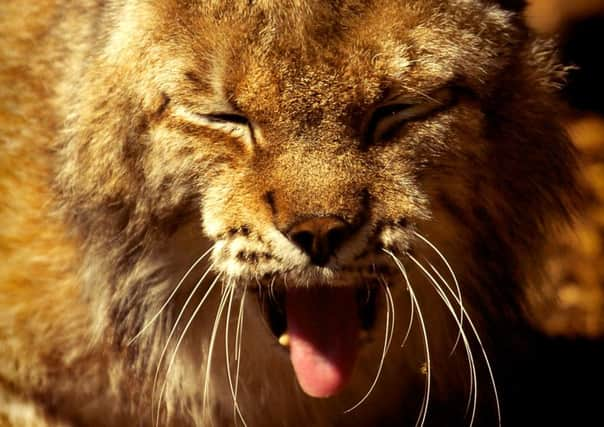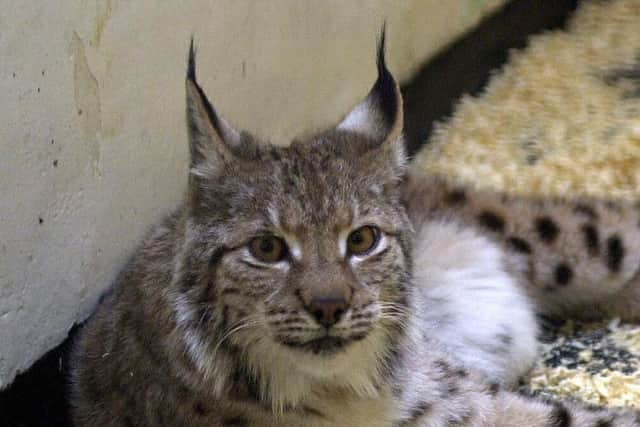Wariness over plan to reintroduce lynx to Scotland


The big cats became extinct in the UK 1,300 years ago.
Lynx UK Trust wants to reintroduce the animals to selected locations in the UK and has requested a meeting with Scottish Natural Heritage.
In a statement, SNH said reintroductions were “complex” and needed “considerable planning” to meet UK and international guidelines.


Advertisement
Hide AdAdvertisement
Hide AdAn area near Huntly in Aberdeenshire has been indentified as a potential location for releasing Eurasian lynx.
SNH has been involved in the reintroduction of sea eagles and rare woolly willows and also a £2 million trial release of European beavers at Knapdale in Argyll. The Scottish Government is to make a decision on beavers being allowed back into the wild later this year.
“If we received an application to reintroduce lynx,” SNH said, “we would be looking for the applicant to provide information on how the project would address ecological issues such as habitat availability, as well as the views of the public, livestock and land managers, the wider UK perspective, and any socio-economic impacts.
“The views of the Scottish Government would need to be taken into consideration. A significant amount of evidence is required to support an application.”
It added: “The Lynx Trust have requested a meeting with SNH to discuss how these conditions might be met.”
Last October, other conservationists argued that efforts to “rewild” parts of Scotland should involve the reintroduction of lynx.
Alan Watson Featherstone, of Trees for Life, said the predator could “play a crucial top-down regulatory role in ecosystems” by helping to control red and roe deer numbers.
Known as the Keeper of Secrets, the elusive forest-dwelling creature would be part of the most ambitious “rewilding” project ever attempted in the UK.
Advertisement
Hide AdAdvertisement
Hide AdIf the Lynx UK Trust’s scheme is approved, the large cats, which prey on deer as well as rabbit and hare, will be released onto three privately-owned, unfenced estates in Norfolk, Cumbria and Aberdeenshire.
“The lynx is one of the most enigmatic, beautiful cats on the planet,” Dr Paul O’Donoghue, a scientific adviser to the trust said. “The British countryside is dying and lynx will bring it back to life.”
The Eurasian lynx is the largest lynx species, with powerful, long legs, with large webbed and furred paws. Due to its solitary and secretive nature, lynx does not present a threat to humans.
The trust launched a public consultation - which closed in March - to determine public reaction to the plan, after which it will lodge a formal application with Natural England and SNH, the government agencies that license such releases.
The trust had over 9,000 responses to its consultation and said the overwhelming majority were in favour.
“The survey is just the first stage of our public consultation process which will also include talks and face to face meetings with interested members of the local community and other stakeholders, based around the proposed reintroduction sites,” said the trust.
If the plan is given the green light, four to six Eurasian lynx wearing GPS tracking collars would be released later this year at each of the sites, all of which are rich in deer and tree cover.
Tony Marmont, a businessman who owns Grumack Forest, near Huntly in Aberdeenshire, said earlier this year that lynx will have an “extremely beneficial effect” on forest ecosystems. He added that lynx would serve as “ambassadors for wider conservation projects”.
Advertisement
Hide AdAdvertisement
Hide AdHowever, not everyone is as enthusiastic, as the economic impact of reintroducing large predators remains controversial.
Previous reintroduction plans have been opposed and sometimes blocked by farmers arguing that creatures such as lynx and birds of prey attack livestock and gamebirds.
The reintroduction of lynx may raise fears of attacks on sheep, although these are rare in areas such as Romania and Poland, where lynx live naturally and a subsidy programme would be set up for farmers.
The National Farmers’ Union is sceptical, with a spokesman for the organisation saying: “We would be concerned about the reintroduction due to its high cost and failure risk. We believe budgets are better focused on developing existing biodiversity.”
In Germany, 14 lynx were reintroduced to a site in the Harz mountains in 2000 and have since bred and colonised other areas. Another reintroduction, in Switzerland in the 1990s, has also seen animals breed and spread.